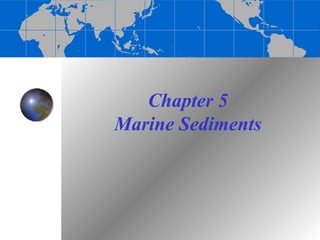
Internet seds
- 2. Ocean sediment Various materials settle through the water column and accumulate on the ocean floor Layers represent a record of Earth history, including: Movement of tectonic plates Past changes in climate Ancient ocean circulation patterns Cataclysmic events
- 3. Collecting ocean sediment Specially designed ships collect cores by rotary drilling Cores allow scientists to analyze ocean sediment
- 4. The 4 main types of sediment 1. Lithogenous = composed of fragments of pre-existing rock material 2. Biogenous = composed of hard remains of once-living organisms 3. Hydrogenous = formed when dissolved materials come out of solution (precipitate) 4. Cosmogenous = derived from outer space
- 5. Origin of lithogenous sediment Forms by: Weathering = breakup of exposed rock Transportation = movement of sediment Deposition = settling and Sediment-transporting media accumulation
- 6. Lithogenous sediment composition Most lithogenous sediment is composed of quartz, which is: Abundant Chemically stable Durable
- 7. Lithogenous sediment texture Texture includes: Grain size Sorting Rounding Maturity
- 8. Distribution of lithogenous sediment Lithogenous sediment occurs as: Neritic (nearshore) deposits Beaches Continental shelves Turbidites Glacial-rafted debris Pelagic (deep ocean floor) deposits Abyssal clay
- 9. Origin of biogenous sediment Organisms that produce hard parts die Material rains down on the ocean floor and accumulates as: Macroscopic shells, bones, teeth Microscopic tests (shells) If comprised of at least 30% test material, called biogenous ooze
- 10. Biogenous sediment composition Microscopic biogenous tests are composed of 2 main chemical compounds: 1. Silica (SiO2) including opal (SiO2 · nH2O) Diatoms (algae) Radiolarians (protozoan) 1. Calcium carbonate or calcite (CaCO3) Coccolithophores (algae) Foraminifers (protozoan)
- 11. Examples of silica-secreting microscopic organisms Diatom Radiolarian
- 12. Siliceous ooze Silica-secreting organisms accumulate to form siliceous ooze (>30% siliceous test material)
- 13. Examples of calcite-secreting microscopic organisms Coccolithophores Foraminifers
- 14. Calcareous ooze Calcite-secreting organisms accumulate to form calcareous ooze (>30% calcareous test material)
- 15. Biogenous ooze turns to rock When biogenous ooze hardens and lithifies, can form: Diatomaceous earth (if composed of diatom-rich ooze) Chalk (if composed of coccolith-rich Chalk cliffs of southern England ooze)
- 16. Distribution of biogenous ooze Most biogenous ooze found as pelagic deposits Factors affecting the distribution of biogenous ooze: Productivity (amount of organisms in surface waters) Destruction (dissolving at depth) Dilution (mixing with lithogenous clays)
- 17. Distribution of siliceous ooze Silica slowly but steadily dissolves in seawater Siliceous ooze found where it accumulates faster than it dissolves
- 18. Distribution of calcareous ooze Calcite dissolves beneath the calcite compensation depth (CCD) at 4.5 km Calcareous ooze can be found below the CCD if it is buried and transported to deep water
- 19. Biogenous ooze as environmental indicator Siliceous ooze Calcareous ooze Surface water Cool Warm temperature Main locations Sea floor beneath Sea floor beneath found cool surface warm surface water in high water in low latitudes; latitudes; not too upwelling areas deep (CCD)
- 20. Origin of hydrogenous sediment Hydrogenous sediment forms when dissolved materials come out of solution (precipitate) Precipitation is caused by a change in conditions including: Changes in temperature Changes in pressure Addition of chemically active fluids
- 21. Types of hydrogenous sediment Mining Manganese nodules manganese Phosphates nodules Carbonates Metal sulfides Evaporite salts Evaporite salts
- 22. Cosmogenous sediment Cosmogenous sediment is composed of material derived from outer space Two main types: 1. Microscopic space dust 2. Macroscopic meteor debris Forms an insignificant Microscopic cosmogenous proportion of ocean sediment spherule
- 23. Mixtures Most ocean sediment is a mixture of sediment types One type of sediment usually dominates, allowing it to be classified as primarily: Lithogenous Biogenous Hydrogenous Cosmogenous
- 24. Worldwide distribution of neritic and pelagic sediment
- 25. Ocean sediments as a resource Ocean sediments contain many important resources, including: Petroleum Gas hydrates Sand and gravel Evaporative salts Phosphorite Manganese nodules and Offshore drilling rig crusts
- 26. End of Chapter 5